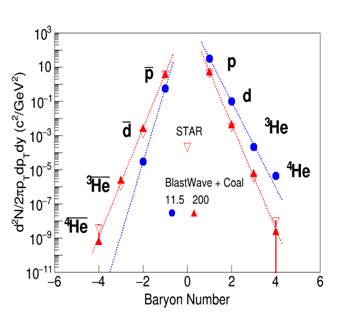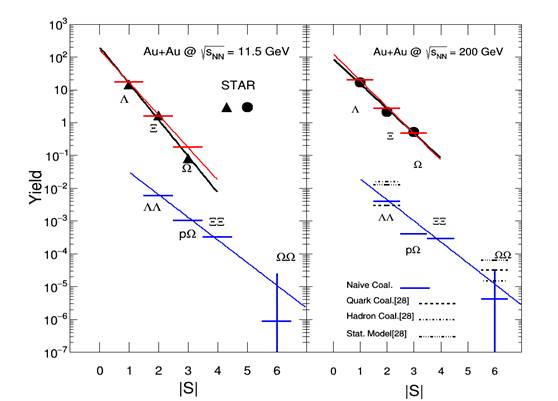Using a na?ve coalescence model based on the phase space distributions of nucleons and Lambdas from a blast wave model, Dr. Neha Shah, Prof. Yu-Gang Ma, Dr. Jin-Hui Chen and Dr. Song Zhang have studied the production of multistrange hadrons, light nuclei, and hypertriton in heavy ion collisions at two energies of 200 and 11.5 GeV/c. The results have been published in Physics Letters B (PLB 754, 6 (2016)).
The study of light (anti)nuclei and (anti)hypernuclei production is important to understand the matter-antimatter symmetry, dark matter and structure of neutron star. The study shows that the reduction factor at lower energy is roughly four times smaller than that for higher energy, which leads to higher probability of production of light nuclei candidates at lower energy. The observed difference in reduction factors between matter and antimatter shows a significant energy (or temperature) dependence, which illustrates an increasing matter-antimatter asymmetry of the yields at lower energies (temperatures). If we make a rough extension to current Universe at room temperature, we can hardly observe the antimatter existence, which is consistent with the current observation of the cosmic rays from which neither antideutron nor antihelium are observed.
Different quantum chromodynamics based models have proposed existence of dibaryons, six quark states or molecular state of two baryons, as exotic form of matter. However, the information about the invariant yield of dibaryons from heavy ion collisions was very limited. In this work, Prof. Yu-Gang Ma's group provided useful calculations for the invariant yield of dibaryons in the strangeness sector using a na?ve coalescence model. Their calculation will provide the motivation to carry out search for these dibaryons during the phase-II of beam energy scan program at STAR experiment at RHIC.
This work is supported in part by the Major State Basic Research Development Program in China under Contract No. 2014CB845400, the National Natural Science Foundation of China under contract Nos. 11421505, 11520101004, 11275250, 11322547, U1232206. Neha Shah is supported by Chinese Academy of Sciences (CAS) President's International Fellowship Initiative No. 2015PM029.

Fig.1 Invariant yield of nuclei in the average transverse momentum region (pT/|B| =0.875GeV/c) as a function of baryon number Bfor central Au+Au collisions at √sNN=11.5GeVand200GeV.

Fig.2pTintegrated yields dN/dyofmultistrange hadrons as a function of strangeness |S|for central Au+Au collisions at √sNN=11.5GeV(left) and 200GeV (right).

